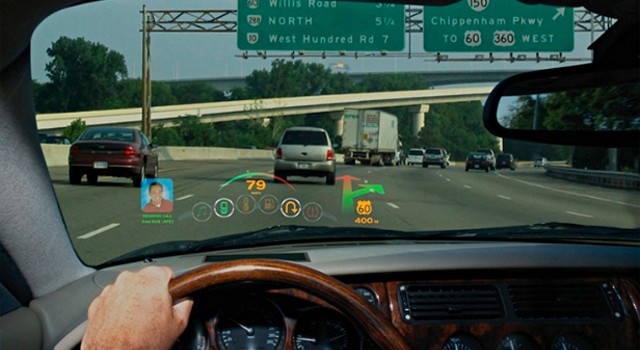Also published in The Legal Examiner, January 29, 2015
By Joel Feldman, Founder of EndDD.org, a project of the Casey Feldman Foundation*
As recently reported by Drew Harwell in the Washington Post, “Heads-up technology puts data on car windshields at CES“, heads-up displays, or “HUDs,” are now the rage, with auto manufacturers and tech companies scrambling to provide more and more information to drivers displayed on their windshields.
What are HUDs?
HUDs are transparent displays of information on a screen positioned between the driver and the windshield, or on or near the windshield itself, with the information appearing in the driver’s line of sight. By projecting the information in the driver’s line of sight the driver does not have to take his or her eyes off the road to look for the information where it is normally displayed, i.e. on the dashboard. Thus the display is referred to as “heads-up” as opposed to “heads down.” Some manufacturers and tech companies are even calling HUDs a solution to distracted driving.
One tech company, Navdy, has been shamelessly marketing its product in a promotional video as follows: “It’s a heads-up display just like what commercial airline pilots use when they’re landing. You hear that? Pilots use it. It’s safe.”
Let’s take a look at the use of HUDs by airline pilots.
The use of HUDs, even by highly trained airline pilots, is not without risk-the danger of “attention capture or cognitive capture”
HUDs were originally developed in WWII for fighter pilots to improve accuracy when using gunsights, and then for improved safety for landing and take-off of military aircraft. Over time, the use of HUDs spread to commercial aircraft. There is appeal to the argument that if information critical for take-off and landing can be displayed in a manner so that pilots do not need to look down or away from the forward direction, safety will be enhanced. However, the use of HUDs has generated a plethora of research and concerns about the effect of HUDs on pilots’ attention and ability to react to unexpected events in their environment. In other words, there are real safety concerns for highly trained pilots when using HUDs. The most comprehensive compilation of information of that research is from a NASA study in 2004, “Head-Up Displays and Attention Capture.”
In the abstract for the study the authors state as follows:
The primary role of head-up displays (HUDs) is to provide primary flight, navigation, and guidance information to the pilot in a forward field-of-view on a head-up transparent screen. Therefore, this theoretically allows for optimal control of an aircraft through the simultaneous scanning of both instrument data and the out-the-window scene. However, despite significant aviation safety benefits afforded by HUDs, a number of accidents have shown that their use does not come without costs.
The authors point to the phenomenon of “attention capture” or “cognitive capture” as a likely cause of the reported accidents. In essence, HUDs project information into what is referred to as the “near domain,” or an area which requires the pilot to focus in the foreground and away from the “far domain,” or areas farther away from the pilot. In doing so pilots tend to react less quickly to events that are happening farther away. There is also the indication that pilots tend to focus longer on the HUD because of its more compelling visual nature to the detriment of looking farther away. Using HUDs requires pilots to switch focus from the HUD to real-life events, referred to as “cognitive switching.” The authors quoted from another study in which “several pilots admitted that from time to time they caught themselves totally fixating on the [HUD], oblivious of anything else, and had to consciously force their attention to the outside scene.” Fischer, E., Haines, R. F., & Price, T. A. (1980), “Cognitive issues in head-up displays” (No. 1711). Moffett Field, CA: NASA Ames Research Center.
Claims that the use of HUDs by drivers is “safe” or that it will reduce distracted driving are not supported by any reliable scientific evidence
Unfortunately, car manufacturers and tech companies are not required to have scientific evidence of claims they make to market their products. To date, I have not seen any scientific study that suggests that the use of HUDs will make drivers safer. Certainly, Navdy has not produced one and I would welcome learning what inquiry Navdy actually did make with respect to the safety of its product prior to marketing it for sale. All of the studies to date, including the ones referenced herein for pilots, indicate that as humans we are not good multi-taskers and that our ability to switch attention is limited. Proponents of HUDs will argue that by projecting information on our windshields and in our line of vision drivers will not take their eyes off the road ahead. Some also ridiculously suggest that since we are wed to our smart phones drivers will continue to use these devices with resulting distraction and that HUDs are needed to combat driver risk-taking. In actuality, wide-scale introduction of HUDs will actually increase ancillary distractions, particularly if manufacturers, like Navdy, advertise that the products are safe.
Sound scientific evidence details our inability to safely multi-task while driving, specifically our inability to perceive and react to changing roadway conditions while operating hands-free devices with our eyes focused on the road ahead. That research has been succinctly summarized as “Hands-free is not risk-free.”
Wouldn’t it make sense to require auto manufacturers and tech companies to prove that HUDs are safe before they are installed in our cars? Studies should be done to see if “cognitive capture” is also a phenomenon for drivers and would adversely effect safety? But the only information that should be considered for HUDs is that required for critical safety operations. Projecting texts, stock quotes, and other non-essential information is only looking for trouble.







